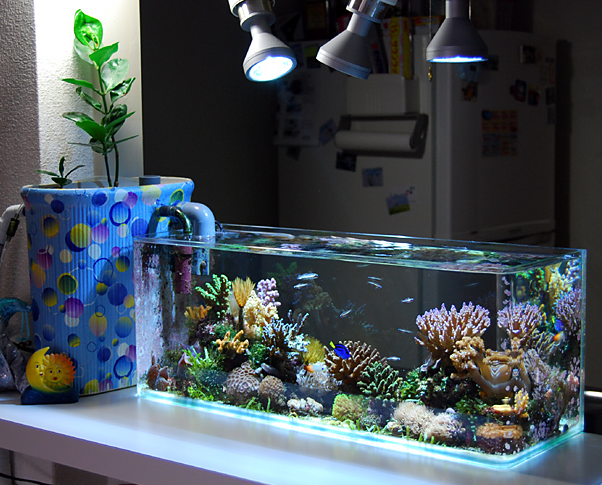
The other day, as I was playing with my (gasp!) freshwater nano-paludarium, it occurred to me that I have become a hardcore fan of nano aquariums. I was inspired to write of my new-found love for these tanks when I stumbled on Jake’s fine piece here on Reef Builders earlier this week. The timing is so right- I’ll throw my two cents worth into the topic! Ok, in the past, I was on the anti-nano bandwagon, vigorously maintaining that they were little more than death row holding cells for their inhabitants, encouraging irresponsibility and overstocking- the usual stuff. I’ve really reversed my position on the topic…well, sort of! Let’s preface it by me asserting that, if you don’t know how to maintain an aquarium, you’ll fail regardless of size. A nano will simply bring you to that point that much more quickly! Since so much has been written on nano husbandry, I’m not gonna bore you with that stuff here. Rather, I’m going to expand on a topic that Jake touched on earlier in the week in his blog that is near and dear to me:
Nano tanks are a valuable tool for experienced hobbyists to practice new concepts on a smaller, more affordable scale.
I like to play with new concepts: Different aquascaping configurations, unique system designs, etc. Nanos offer me a flexible, relatively simple means of trying new things without the “bloodshed” involved with a larger system. I love the idea that I can visualize something, sketch it out on Friday afternoon, and have it well underway on Saturday, completed Saturday evening with only one or two trips to Home Depot, and only a few gallons of water on my hardwood floor! Cool!
I submit to you, however, that nanos WILL become addictive. And they can even be expensive! If you go into things full-bore, like this geek does, you’ll still find ways to spend lots of hard-earned cash to create a neat little tank. When I started playing with nano systems, I decided from the outset that they would be way more than a simple testbed. Each nano would have to stand up on its own as an example of good aeshetics. No dangling powerheads or heaters, mix-and-match tank components, etc. for me. I love those ADA “Cube Garden” tanks! Cha ching!
If these little things are going to be in my living room, they are going to have to look nice. And, unfortunately, for me- “nice” occasionally translates into “pricey”! You don’t HAVE to spend the big bucks on nano tanks of course- and I discourage you from feeling obligated to do so- but it amazes me what you can end up with when you start out with quality, even on these tiny tanks
After visiting Jake’s house and seeing his many small and unique systems, I left with my head filled with all sorts of ideas for interesting nano displays …and there are endless possibilities for nanos, kids. Gawking at Jake’s nano systems helped me see the subtle beauty in details often overlooked on our larger systems. I won’t soon forget that visit.

I entered the nano game with a little freshwater paludarium system, which I have been messing with for many months now. Not only did it allow me to have fun with a different “medium” (fresh water!), it enabled me to hone some skills I will need when I take the concept to a larger marine system soon. As reef hobbyists, we seem to collectively be always looking over the next mountain to see what’s on the other side, and nanos make that climb a bit easier.
Which brings us back to the point of the whole thing. If done responsibly, a nano system can be every bit as sexy and interesting as that 400 gallon behemoth you’re drooling over-and still allow you to meet the monthly mortgage. But most important of all- nanos allow us as hobbyists to more easily push the state of the art. They are way more than the goldfish bowl of the 21st century!
It’s a little easier to break down that 4 gallon Palau coral shoreline mangrove picotope system when your dream crashes down in flames than it is to break down the 125 gallon version, trust me! And it’s waaay less expensive to make a lookdown Ricordea bottom tank on that 2.5 gallon system as well! Test an idea that’s popped into your head. See if you like it. See if it is even workable. Practice working in the tank. Study flow, evaporation, concealing plumbing, etc. You’ll definitely learn things and hone skills that you will incorporate daily with your larger systems. Keeping a nano can and will demand more from you than you think, and it will make you a better, more well-rounded hobbyist!
Rather than just using the nano to keep a pair of Clownfish, or a Shrimp/Prawn Goby association (yawn…again?), try something totally radical: A simulated shoreline, a mangrove root system, a sand-flat biotope, a sponge-dominated cryptic zone, an Amano-inspired seagrass display, etc. Push the state of the art in both aquascaping and husbandry! Don’t use the nano as a means to see how many fish you can cram in there- use it to see how we can more appropriately house a given species of animal, or execute a system that’s rarely been done before!
Without beating a dead horse, I encourage those of you who have not yet done so to hop on the “nano train”. See where it takes you- push yourself-advance the hobby, and share your brilliance! There has never been a better time to “think small”.
Till next time…
Stay wet.
Scott Fellman
Facebook.com/scott.fellman



